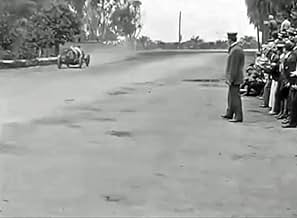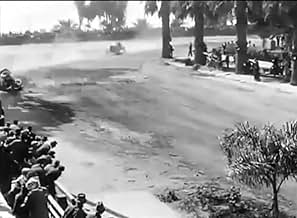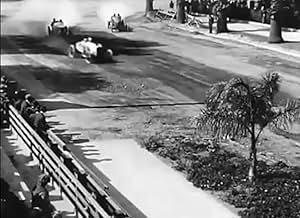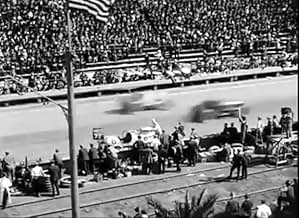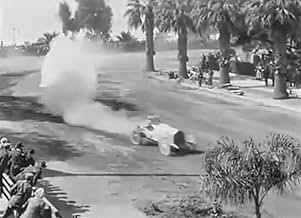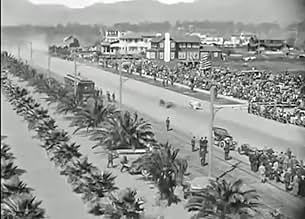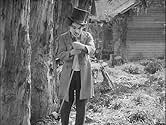Adicionar um enredo no seu idiomaCharlie, competing with his rival's race car, offers Mabel a ride on his motorcycle but drops her in a puddle. He next joins some dubious characters in abduction of his rival just before the... Ler tudoCharlie, competing with his rival's race car, offers Mabel a ride on his motorcycle but drops her in a puddle. He next joins some dubious characters in abduction of his rival just before the race for the Vanderbilt Cup. With her boyfriend locked up in a shed, Mabel takes his plac... Ler tudoCharlie, competing with his rival's race car, offers Mabel a ride on his motorcycle but drops her in a puddle. He next joins some dubious characters in abduction of his rival just before the race for the Vanderbilt Cup. With her boyfriend locked up in a shed, Mabel takes his place. Charlie does what he can to sabotage the race, even causing Mabel's car to overturn.
- Direção
- Roteirista
- Artistas
- Henchman
- (as Andy Anderson)
- Cheering Spectator
- (não creditado)
- Spectator in Grandstand
- (não creditado)
- Mabel's friend and race spectator
- (não creditado)
- Race Spectator
- (não creditado)
- Spectator in Grandstand
- (não creditado)
- Spectator in Grandstand
- (não creditado)
- Spectator in Grandstand
- (não creditado)
- Cheering Spectator
- (não creditado)
- Henchman
- (não creditado)
Avaliações em destaque
Chaplin hadn't gotten along with his earlier directors, Henry Lehrman and George Nichols, but according to his autobiography having to take direction from a mere "girl" was the last straw. Charlie and Mabel argued bitterly during the making of this film. Chaplin was still a newcomer at Keystone and his colleagues didn't know what to make of him, but everyone loved Mabel. Producer Mack Sennett was on the verge of firing Chaplin when he learned that the newcomer's films were catching on and exhibitors wanted more of them A.S.A.P., so Chaplin was promised the chance to direct himself in return for finishing this movie the way Mabel wanted it.
In light of all this it's appropriate that Charlie and Mabel are at odds during much of Mabel at the Wheel. In the opening sequence Charlie is courting Mabel and offers her a ride on his bike, but she tumbles off into a mud-hole and, soon afterward, Charlie reveals his villainous nature. We notice right away that Chaplin looks odd here, sporting a goat-like beard on his chin and wearing the top hat and frock coat from his very first film appearance, Making a Living. The outfit suits the over-sized, Ford Sterling-style villainy he displays. He's certainly no gentleman. When Mabel strikes him across the face he promptly hits her back, and during the course of the film he sticks a pin in almost everyone's derrière. What a mean guy! The central plot concerns an auto race in which Mabel's beau (Harry McCoy) is scheduled to compete, but wicked Charlie and his henchmen abduct the lad, and Mabel must take the wheel in his place. For all the racing around, brick hurling and finger-biting the film is frankly short on laughs, but there are some points of interest. There's good cinematography and editing in the race sequence, though there aren't really any gags, just lots of frantic activity. Visible in the stands at the race track are several Keystone stalwarts such as Chester Conklin, Edgar Kennedy in a strangely dandified get-up, and a more characteristic Mack Sennett, hawking up spit and doing his usual mindless rube routine. As a performer Sennett was about as subtle as the movies he produced, but you have to give him credit: he knew what people liked. These films were hugely popular in their day. Mack's performance doesn't add much to Mabel at the Wheel, but he probably had to be on hand for the filming just to make sure his stars didn't murder each other.
** 1/2 (out of 4)
The behind the scenes issues with this movie are pretty interesting but from what I've read Chaplin hated being directed by a woman and his constant battles with Normand almost got him fired. For whatever reason Keystone decided to keep him and Chaplin's hatred of "other directors" finally caused him to be directed by himself from this point on in his career. In the film Mabel and her boyfriend (Harry McCoy) have a falling out so she takes a ride with his rival (Chaplin) but she eventually gets knocked off his bike and into a puddle of mud. Later she's back with the boyfriend who's at a race track when Chaplin kidnaps him forcing Mabel to race the car. This is a mixed bag as far as the film goes because the first half is pretty funny but the second half dealing with the race falls apart. Seeing Chaplin and Mabel slap one another makes you wonder how much they both enjoyed it but these early scenes are certainly the best in the film. The actual auto race wasn't too thrilling or funny to me but things do pick up towards the end and Chaplin's final scene is very funny.
Mabel was all sweetness after the furore, although she was unsure about riding pillion with Charlie on the Keystone motorbike – a type of machine he claimed to have ridden before. According to Mabel, the crazy Briton crashed the bike into a ditch before they'd gone twenty yards. He'd lied! Once he'd mastered the technique, all was set for a mad ride along a muddy track, where the hapless Mabel would be dumped in a mud pool. This was the cue for the usual Keystone battle of bricks between Mabel plus boyfriend and Charlie. Interesting how there are always some handy bricks lying around to be thrown by inmates of Sennett's 'University of Nonsense'. Charlie becomes a Ford Sterling- type villain for this film, and initiates various dastardly deeds, such as sticking a pin into Mabel's leg, thumping her in the face, and tying her boyfriend up. Without wishing to give the whole plot away, Mabel ends up taking over her boyfriend's racing car drive. The whole film is clearly based around a famous race filmed in Santa Monica, where a front wheel breaks off a car at Dead Man's Curve, causing it to overturn in spectacular fashion. Mabel openly enjoys the adulation she receives from the spectators and team at the conclusion of the race. Oh, how the cast adored their Keystone Girl!
Things to Note: [1] Charlie's motorbike is a chain drive 1912 Thor IV model. [2] The No. 4 racing car could be Sennett's own Stutz. [3] It is amusing to see the startled old fellow in shirtsleeves and braces,standing in his garden watching Charlie restart his motorbike – he thinks the Hell's Angels are in town. [4] Many roads around Hollywood in those days were seemingly rutted, muddy tracks. [5] When Mabel and Charlie have a fight, a seated spectator looks bemused,then positively scared.[ 6] The entire Keystone company appears to be in this film. [7] The race team's toolkit consists of one spanner, a file, a hand drill, and a bucket. High-tech that. [8] Mabel thinks race preparation comprises taking out a compact and powdering her nose. [9] The mechanic is in the race car to pump fuel and oil (furiously). [10] When the actual race car crashes, the mechanic is thrown out onto his feet. In the faked keystone crash scene the mechanic ends up under the vehicle.[11] There are plenty enough gags for Charlie in the film, and the lack of the standing on the hose gag (which caused the two stars to fall out) does not detract from the film. [12] Charlie reverts to a type of Ford Sterling costume for this film. Could it be that Mabel refused to work with the Tramp, as she feared being upstaged by the scruffy character? She might also have been fearful of the filthy Tramp outfit (Mrs Arbuckle claimed that Mabel used to buy Charlie new clothing, as he never washed his attire).
The story is clear, not overly confusing plus the racing sequences are very interesting. It seems that there was more effort put into this one than many other Keystone productions. It might be because Mable Normand directed this film together with Mack Sennet. Mable, being a star, wanted a more polished film.
'Mabel at the Wheel' is one of the best early Chaplin's movies and probably my favorite Mabel Normand movie. It was his eleventh film - imagine - making eleven movies within barely three months. What a schedule.
I hereby recommend reading wmorrow59 review which shares some light behind the scenes on how Mabel and Chaplin didn't get along.
In an article called "Speeding Sweethearts of the Silent Screen," film historian William Drew notes that after Mary Pickford's car chase movie "A Beast At Bay" (Griffith, 1912), this is only the third movie to feature a woman's driving. It will only become standard in movies starting in 1915. Drew notes, "In fact, one can view Mabel at the Wheel as a kind of feminist parable with the heroine defeating the male competitors on the race course as well as the villainous Chaplin." Besides seeing Mabel Normand's feminist heroics, the other reason this film, directed by Ms. Normand, is noteworthy is Chaplin's unique performance. He plays the villain wearing a trench coat and whiskers. Through much of the film, he does what seems like a perfect impression of comedian Ford Sterling. At one point, Chaplin even crosses his eyes like Sterling. It should be remembered that Chaplin was hired at Keystone to replace Ford Sterling. In fact Chaplin's tramp costume uses Sterling's large size shoes, perhaps symbolizing the fact that he was hired to fill Sterling's shoes literally as well as figuratively.
The first five minutes of the film is quite different from the rest. Chaplin plays simply Harry McCoy's rival for Mabel Normand. This is exactly the same triangle we saw in Chaplin's first film, "Making a Living." The second five minutes of the film is different with Chaplin suddenly turning into a ridiculous villain caricature. He goes around jabbing people and tires with a pin.
There is a scene where Chaplin takes out a water hose to water a race car course. Apparently, Chaplin refused to do it. Chaplin probably did not see the humor in endangering people's lives. Slapping, punching, pricking and kicking people is one thing, but actually endangering people's lives is another. He worked off the set.
Famously, Mack Sennett threatened to fire him. He submitted and played the rest of the movie as Normand wanted him to, in Ford Sterling absurdist style. We should remember that Chaplin's humor was based on the funny drunk sketch he made famous. The drunk is funny, but not absurd. The absurd humor that Keystone dealt with was simply not something that Chaplin appreciated.
This is really a Mabel Normand film and it seems unfair to give Sennett credit for directing it when all he did was discipline Chaplin. Normand had her own problems with Sennett and was probably only staying with him at the time because he gave her the opportunity to direct.
There are some powerful images in the film: Mabel falling off a motorcycle, Mabel behind the wheel of the car with mechanic William Hauber, Charlie sitting next to Mabel and jabbing her with a pin and her jabbing him right back, and Mack Sennett as a country bumpkin in a cameo appearance. It seems possible that Mabel was expressing how she really felt about Sennett by having him act this way.
The original film was 1900 feet and the restored version is about 1400. Please keep in mind that over 25% of the film is still missing. Probably the jumpy, quick shots in the racing scenes were much smoother with longer shots in the original.
Sennett supposedly got a telegram from his partners in New York demanding more Chaplin films during the production of this film and only this telegram stopped him from firing Chaplin. I tend to think that it was the success of this movie that really put Chaplin on the map. While Chaplin was fine in his first ten films, there was nothing particularly distinguishing about him. This two-reeler would have established him as the real replacement for the popular Ford Sterling.
Você sabia?
- CuriosidadesThe motorcycle in the opening scene is a Thor Motorcycle Model M Type IV.
- Erros de gravaçãoIn the hilarious scene where Mabel gets dropped in the mud puddle, and where she splashes around getting out/up, she is clearly soaked. Immediately after, when Harry McCoy rolls up in the race car, Mabel runs up to him, and despite some splashes on her dress, she is more or less dry.
- ConexõesFeatured in Charles Chaplin, O Homem Mais Engraçado do Mundo (1967)
Principais escolhas
Detalhes
- Data de lançamento
- País de origem
- Centrais de atendimento oficiais
- Idiomas
- Também conhecido como
- Mabel at the Wheel
- Locações de filme
- Empresa de produção
- Consulte mais créditos da empresa na IMDbPro
- Tempo de duração23 minutos
- Cor
- Mixagem de som
- Proporção
- 1.33 : 1
Contribua para esta página


